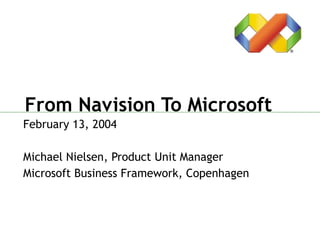From Navision To Microsoft
- 1. From Navision To Microsoft February 13, 2004 Michael Nielsen, Product Unit Manager Microsoft Business Framework, Copenhagen
- 2. Michael Nielsen CV 1986 Master of Science in Engineering (DTU) 1986 UNIX Developer with Knudsen & Johnsen 1987 Joined Navision Software 1987 Developer, Navision 1.x report writer 1989 Developer, AL-Language 1990 Developer, Navision 3.x IDE 1993 Program Manager, Navision Windows client 1995 General Manager of Tools department 1997 Director of Product Development 1998 Director of System Architecture 2000 Director of Navision Research 2002 Product Unit Manager, MBS Frameworks 2003 Product Unit Manager, Visual Studio
- 3. How it all started! (1984)
- 4. PC Plus (1985) - Ease of use PC based Document style look and feel Online help Exception handling Low on demand for computer resources
- 5. PC Plus v1 (1985)
- 6. Navigator v. 1 & 2 (1987)- Multi-user Client / Server Transactions Versioning OLAP Programmable report writer
- 7. Navigator 3.x (1990) - Development platform AL Programming language Function libraries Design tools - Forms, Tables, Reports Structured exception handling Resource management
- 8. Navision 3.5 - Cross platform Support for UNIX and Windows NT ODBC C-Toolkit Third party SQL support for Oracle and Informix
- 9. Navision Financials - 1st Prototype (1992)
- 10. Navision Financials - Standard UI Windows 95 look and feel Compatible with Microsoft Office Microsoft Access like development tools Microsoft logos
- 11. Navision Financials 1.0 - Released Product (1995)
- 12. Navision Around the World Local Navision companies Partners Navision reached companies all over the world. In 2002 Navision had local companies in 30 countries and partners in 94 countries.
- 13. Five-year Financial Performance DKK in millions Net revenues EBITA DKK in millions
- 16. Moving to Visual Studio (2003) Microsoft Business Framework is part of Visual Studio! Leverages the familiarity of Visual Studio Introduces abstractions related to the application domain Guides the developer (âprescriptive-nessâ) Uses the model as a master â not the code Keeps the freedom to code Uses concepts from Intentional & Aspect oriented programming
- 17. Model-driven architecture â The next wave (2004) From Code based OO programming to modeling
- 18. Ėý

















